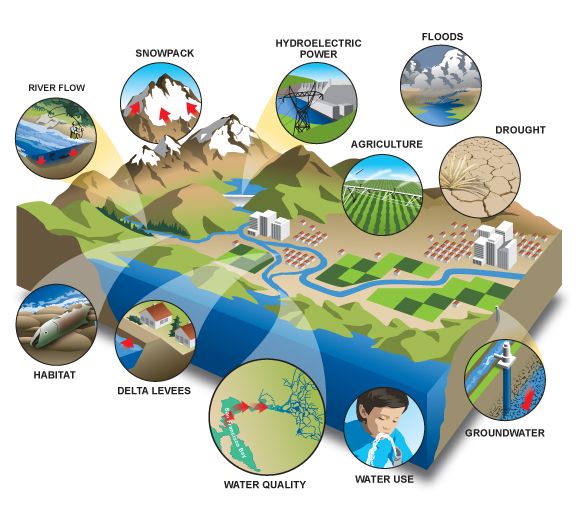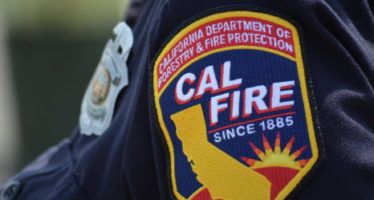CA Confused on "Drought" Meaning
BY WAYNE LUSVARDI
California’s drought barometer and vocabulary need to be reformed.
The bureaucratic apparatus in California perpetually says the state is in a “drought.” In fact, with snowpack running at 124 percent of normal, the California Department of Water Resources says the state’s hydrological drought is over.
After several years, the U.S. Drought Monitor map finally indicates no part of California is abnormally dry, extending to the parched Colorado River basin. Nevertheless, the 2008 drought proclamation of former Gov. Arnold Schwarzenegger remains in effect.
As the public keeps complaining in comments left at online newspaper forums that the drought is over, public water officials continue their Bureau-speak that all that rainfall does nothing to reduce the drought. Even though the public and the water bureaucrats use the same language, it doesn’t mean the same thing.
The reason that the public and the bureaucrats talk past each other is that the public is talking about short-term snowpack and reservoir level, and the water officials are talking about long-term trends. Contrary to myths perpetuated by environmentalists, in a wet year farmers and cities combined only use about 35 percent of dedicated water supplies, but the environment gets about 65 percent. In a dry year, the percentages reverse.
Thus, anyone can point to whatever yearly data they want to prove drought or deluge. As Mark Twain noted long ago, there are no unbiased people about water in California, just some people who may be apathetic.
In the last five years, the supply of water to farms has be curtailed by as much as 85 percent due to environmental lawsuits resulting in court-ordered cutbacks in shipments through the California Aqueduct. During roughly the same time period, Southern California has shifted from two-thirds dependence on Colorado River water to two-thirds reliance on the State Water Project via the Sacramento Delta.
The Metropolitan Water District is considering recommending lifting the water restrictions, as reservoirs have refilled their storage. But for how long? If we have, say, five dry years in succession, we’re back to a drought, which is normal in California. So, to water managers we might as well start conserving now, because the future is uncertain.
New Drought Vocabulary Needed
What we need is a new drought vocabulary in California. It seems that every type of shortage of water in California is called a drought. And logically speaking, if everything is called a drought, nothing is.
Typically, we associate the word drought with a water shortage condition of natural origin. But not every “drought” is a drought. Some water shortages we call drought are thought mostly to be natural, some climatological, some judicial, some demographic and some regulatory. But they all end up being called “drought.” When in doubt, calling everything a drought seems to be the rule.
So a lawsuit-induced drought may be disguised as a natural drought. That’s the situation in California today as a 3-year natural drought condition is covering for a court-ordered shut off of 85 percent of water to Southern California due to an environmental lawsuit to protect the Sacramento Delta smelt fish.
But if the natural drought subsides, what then will we call our water shortage situation? Drought seems a most inappropriate term to call a court-ordered shortage of water due to an environmental lawsuit, when there may be an abundance of water available.
Drought is a near-permanent normal condition in California, especially in Southern California. But even in dry Southern California, enough water flows to the sea in a typical rainy winter week to supply the population for a year.
So what we experience as drought is the lack of water capture and storage (i.e., slippage). What we conventionally call a drought in California is the unpredictable skipping of a peak rainfall year that typically supplies an overflow of water sufficient to fill reservoirs to last a few years for farmers and coastal cities.
In California, much of the landscape has Spanish names derived from the days of the Mexican land grants. Even weather conditions, such as El Niño and La Niña (“Little Boy” and “Little Girl”), are derived from the Spanish language.
So if we are to look for another set of names to nuance all the different types of drought, perhaps we should look to Spanish words.
As stated above, what we conventionally call a drought is the missing of a peak rainfall year to fill up reservoirs and snow pack to last for a few years of normal drought. So we need a word in Spanish that means the lack of a peak wet year.
In Spanish, the word punta means peak.
The prefix “a” means “none,” “lack of,” “without,” “absence of.”
Putting the prefix “a” in front of the Spanish word punta results in the word apunta.
So perhaps what we should call most of our droughts is an apunta or apunta ano, meaning the absence of a peak rainfall year. Use of the word or phrase would take getting accustomed to. But at least it more accurately describes what we call “drought” in California.
Other Terms
Which raises another question: What then do we call other water shortage conditions drought? Other obvious terms come to mind:
Judicial apunta: a court-ordered water shortfall.
Regulatory apunta: a water shortfall caused by some regulatory agency but not the state Legislature.
Legislative apunta: a water shortfall caused mainly by legislation (such as AB 32).
Demographic apunta: a population-induced water shortfall.
El Niño or La Niña apunta: a water shortfall from ocean water temperature in the Pacific Ocean.
Ag apunta: a water shortfall caused mainly by farmers switching to permanent all-year-round crops.
Lago apunta: drought caused by a lack of water storage reservoirs in watersheds
Junta apunta: the humorous sounding but serious term referring to a water shortfall caused by a small group militantly seizing power in a coup or junta (e.g., the Aral Sea in Uzbekistan — an inland sea intentionally shrunk to the status of a lake and wasteland resulting from Soviet central planning in the 1950’s).
Junta punta: a term referring to the aggregation of water caused by centralized planning (e.g., when the Metropolitan Water District of Southern California built the Colorado Aqueduct and spillage resulted in the creation of the Salton Sea in Southwestern California).
UNTA punta: a totally unserious term meaning an accidental spill of water caused by some bureaucratic agency (e.g., the United Nations Transitional Authority or the fictional University of North Tulare Authority).
Better Terminology Needed
All kidding aside, California needs better drought terminology.
Words are often used in bad faith. They are used to obscure human responsibility. As sociologist Peter L. Berger states: “Bad faith is to pretend something is necessary that is in fact voluntary.”
The word “drought” is used to serve as a cover for man-made drought. What is ultimately man-made is made out as caused by nature.
Nuancing better terms for drought in California may be a first step toward better public education about water management, no matter what terms may eventually gain acceptance by the public. But for now the terms “apunta” or “apunta ano” are proposed to begin a dialogue on better drought terminology for eventual adoption by the media and California’s nomenklatura.
Related Articles
Assembly OKs Prisoner Dump
MARCH 18, 2011 By DAVE ROBERTS On a straight party-line vote, California Assembly Democrats approved a public safety bill on
Markets ‘Crush’ Brown's Windmill Fantasy
JULY 29, 2011 By WAYNE LUSVARDI With the swagger of a boxer before a match, on July 24 Gov. Jerry
With brutal fire season expected, fight over how to respond has never stopped
California’s perilous experiences with massive wildfires reached an all-time peak in 2017, as the state suffered through its worst blaze




